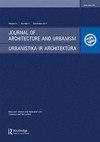从脊柱中汲取灵感,设计一座人行天桥【以脊柱为灵感的人行天桥设计】
IF 0.8
0 ARCHITECTURE
引用次数: 1
摘要
众所周知,自然结构是美学、功能和结构领域众多建筑和结构规则的灵感来源;因此,应用控制它们的原则可以进行适当和优化的设计。为设计一座100米跨径人行天桥的结构,对桥梁的自然荷载传递结构进行了建模。这座桥位于德黑兰以南230公里的卡尚旅游区的一个山区公园。为此,通过研究自然界的模式,为这一问题提供了一个相关的答案,动物的脊椎被确定为身体的承载骨架,是模式的最佳选择。受到它的启发,一个稳定的结构被设计为没有中间支柱的桥梁骨架。这座桥的设计灵感来自于四足动物的脊椎。为了控制桥梁结构在荷载作用下的稳定性,利用Grasshopper软件中的Karamba插件对初始设计思路进行分析,找出其不足之处,得出最终设计方案。采用SAP2000结构有限元软件对最终设计进行了分析,确保了结构的稳定性和允许变形的控制。此外,对脊柱模块化结构的关注是桥梁部件预制元素设计的灵感来源,这除了降低执行成本外,还提高了项目的施工速度。人行天桥的最终设计在荷载传递方面类似于悬索桥,灵感来自四足脊椎动物的结构,是桁架和张拉整体结构的结合,除了视觉美学之外,还具有最佳的结构性能。本文章由计算机程序翻译,如有差异,请以英文原文为准。
DRAWING INSPIRATION FROM THE SPINE, DESIGNING A PEDESTRIAN BRIDGE [SPINE-INSPIRED DESIGN OF A PEDESTRIAN BRIDGE]
Natural structures are known to be the source of inspiration for numerous architectural and structural rules in the fields of aesthetics, function, and structure; therefore, the application of the principals governing them could be used for appropriate and optimal design. The present paper was conducted to model the natural structure of load transfer in order to design the structure of a pedestrian bridge with a span of 100 meters. This bridge is located in a mountain park in the tourist area of Kashan, 230 km south of Tehran. For this purpose, by examining the patterns in the nature, which provides a relevant answer to the problem, the spine of animals was identified as the bearing skeleton of the body, the best option for patterning. Inspired by it, a stable structure was designed as a skeleton of a bridge without a middle pillar. Based on a form inspired by the spine of a four-legged animal, the bridge structure was designed. To control the stability of the bridge structure against the loads, the initial design idea was analysed employing the Karamba plugin in Grasshopper software to identify its weaknesses and the final design was obtained. The final design was analysed with SAP2000 structural finite element software to ensure the stability and control of permissible deformations. Additionally, attention to the modular structure of the spine was the source of inspiration for the design of prefabricated elements of the bridge parts, which in addition to reducing the cost of execution, increases the speed of construction of the project. The final design of the pedestrian bridge, which acts similar to a suspension bridge in terms of load transfer and was inspired by the structure of a four-legged vertebrate, is a combination of truss and tensegrity structure and in addition to visual aesthetic, has optimal structural performance.
求助全文
通过发布文献求助,成功后即可免费获取论文全文。
去求助
来源期刊

Journal of Architecture and Urbanism
ARCHITECTURE-
CiteScore
1.30
自引率
14.30%
发文量
12
审稿时长
15 weeks
期刊介绍:
The Journal of Architecture and Urbanism publishes original research on all aspects of urban architecture.
 求助内容:
求助内容: 应助结果提醒方式:
应助结果提醒方式:


